This document provides background information on characters and events related to the Roman Empire through summaries of movies and research on Roman cultures and traditions. It discusses key figures in the assassination of Julius Caesar like Brutus, Cassius, and Casca. It also summarizes the plot and main character Maximus in the film "Gladiator" and provides facts about gladiators in Roman times. The document is a research report for a school assignment on the Roman Empire.
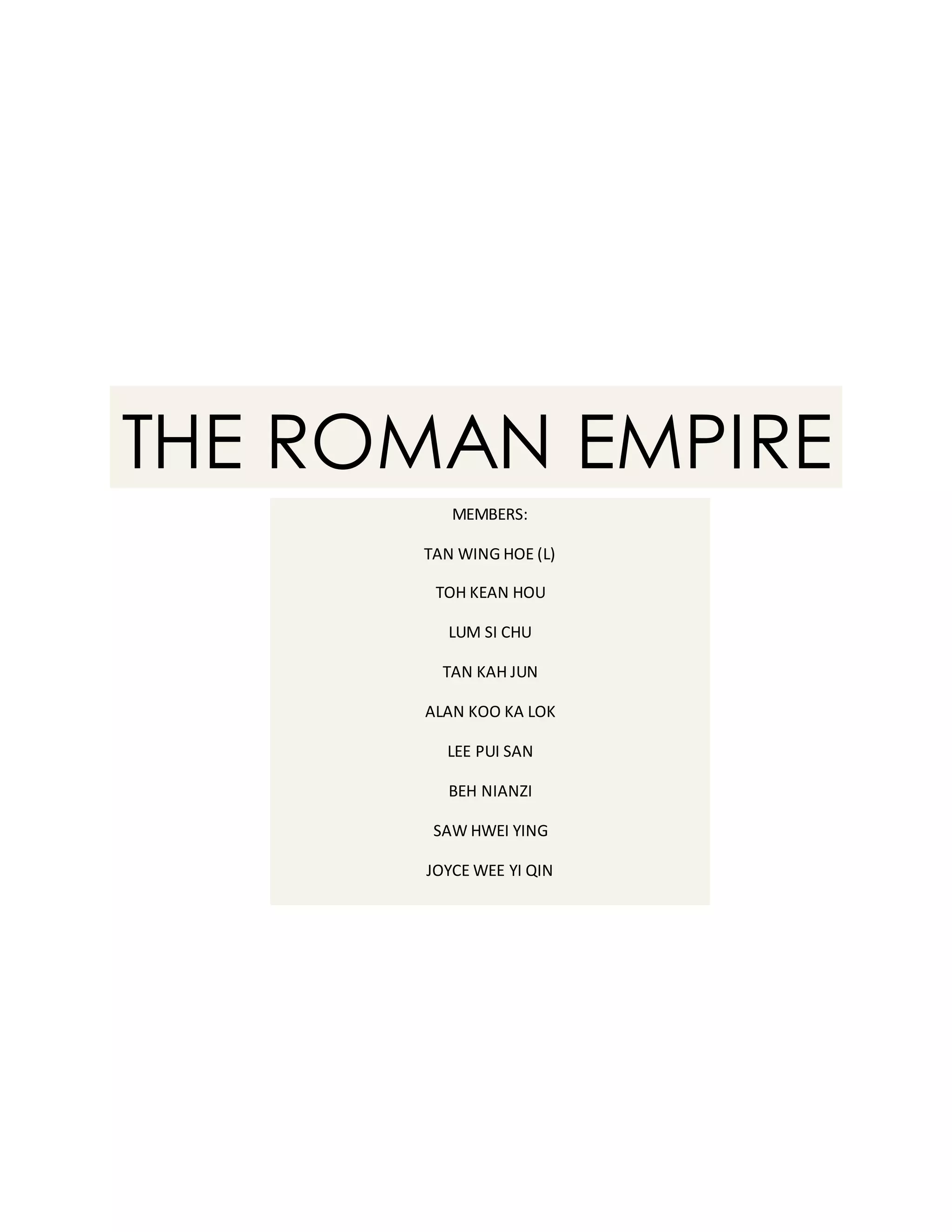
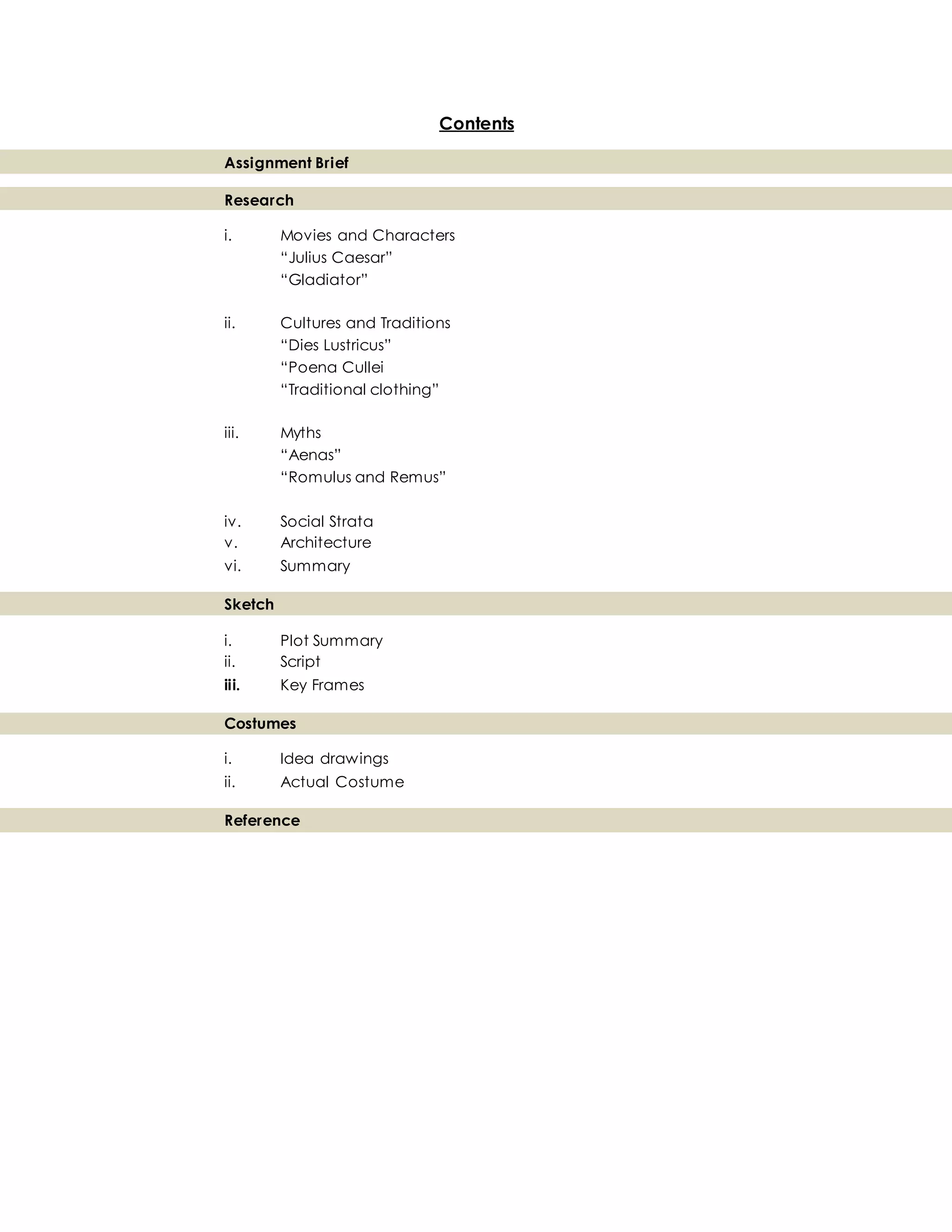
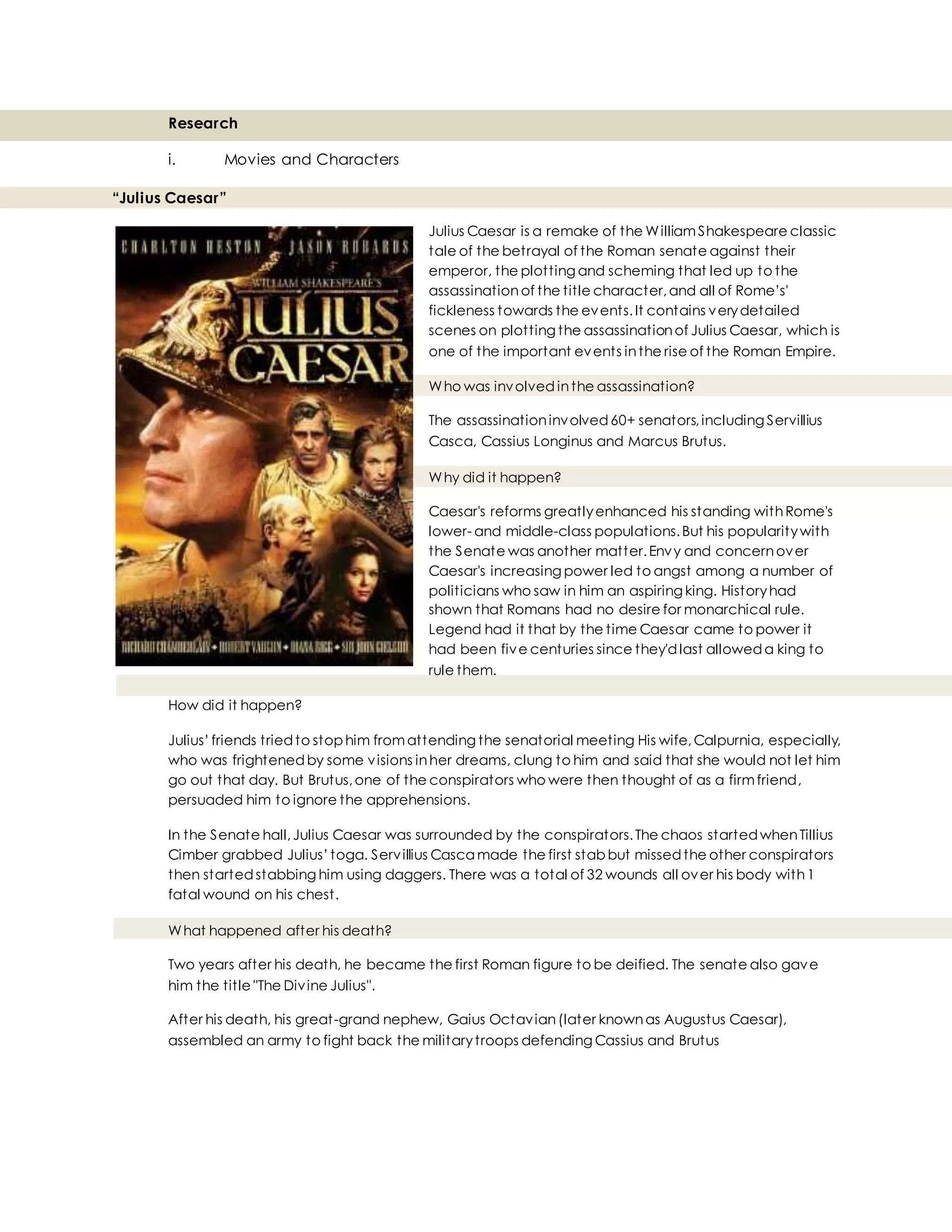
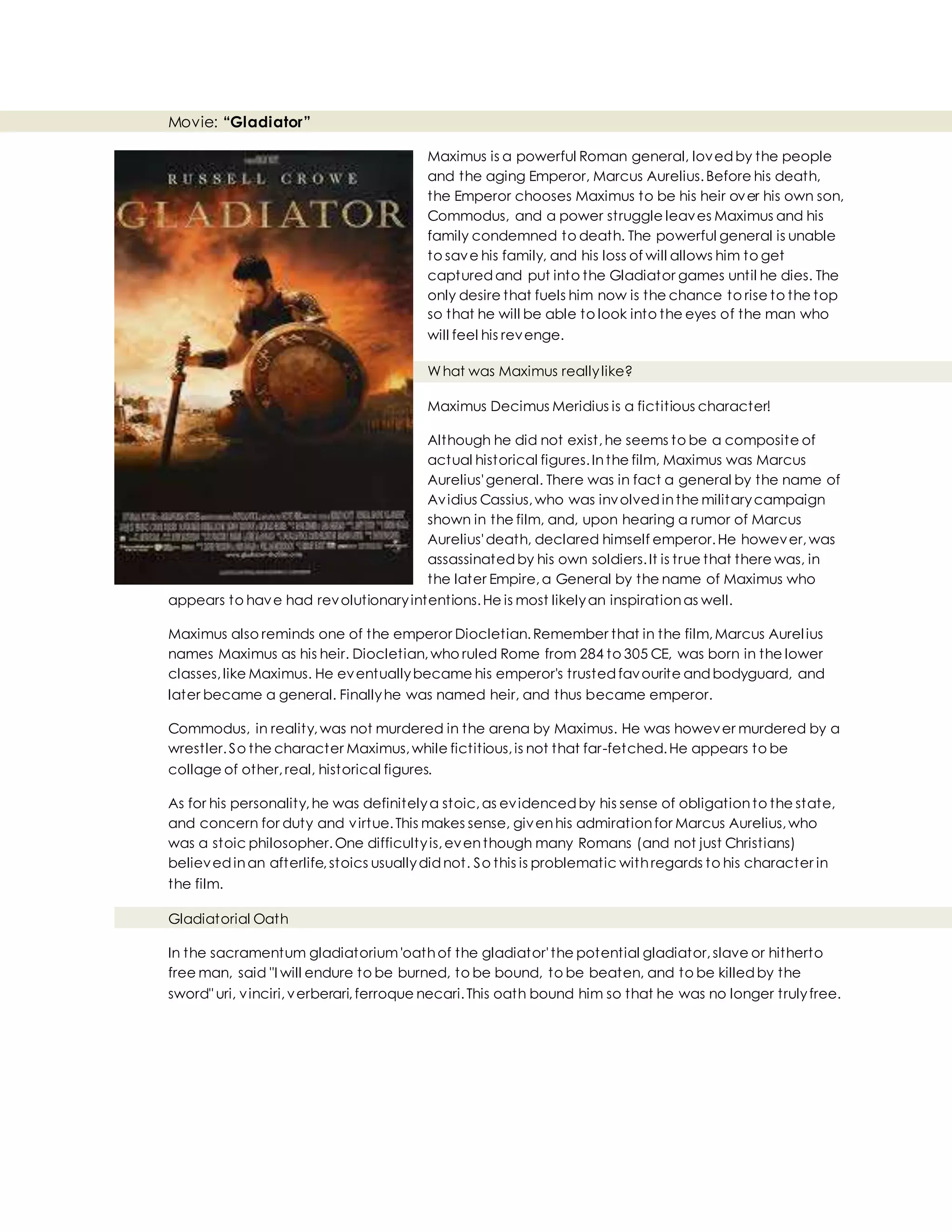
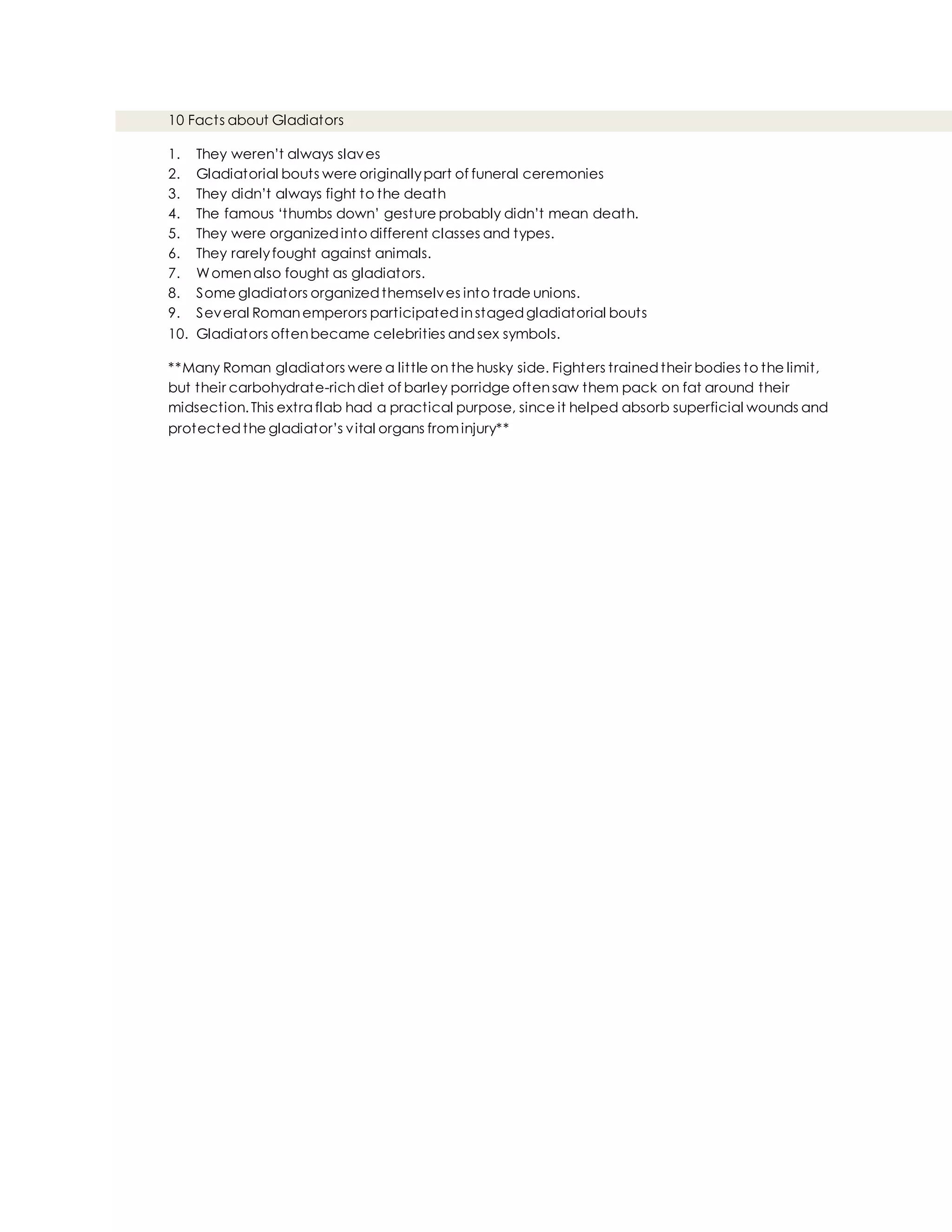
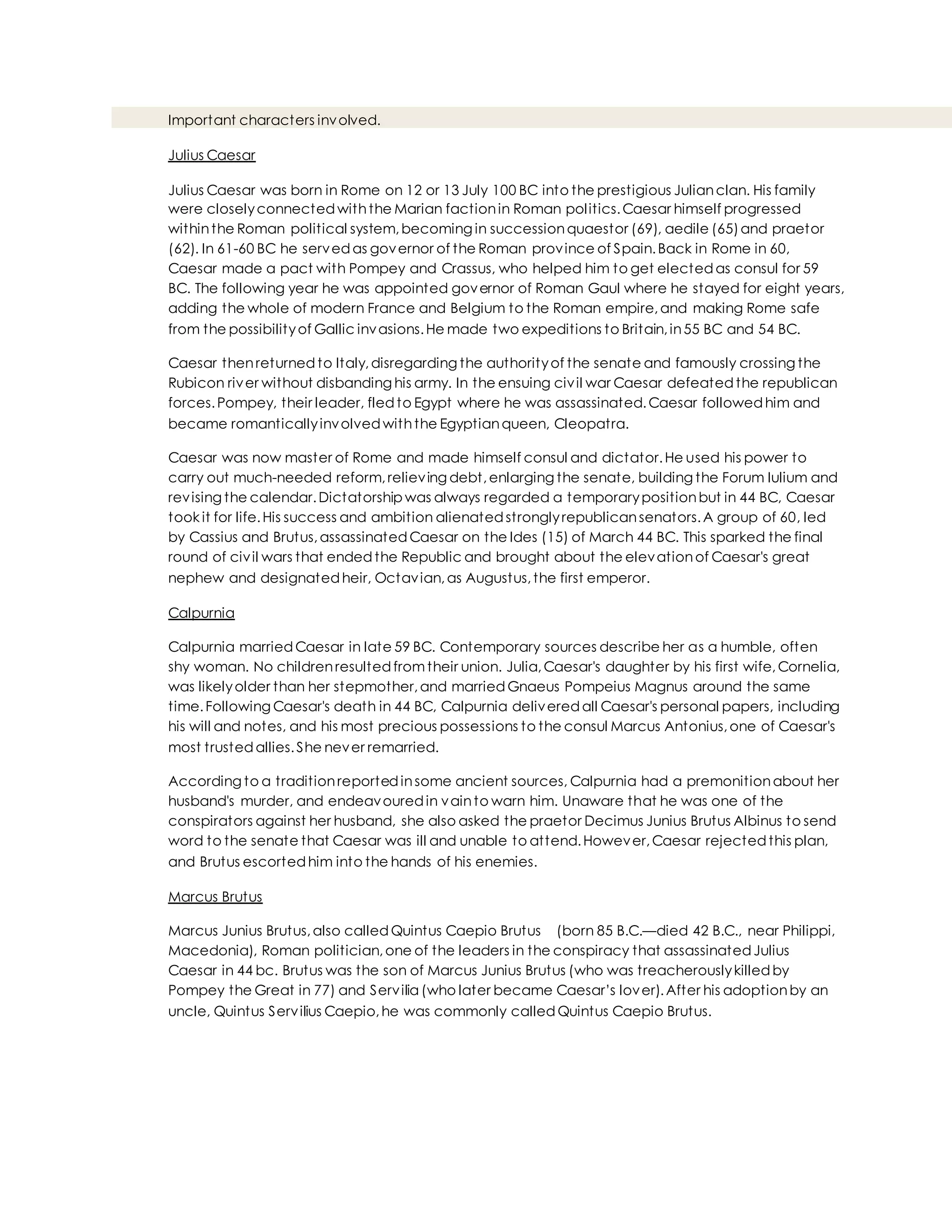
![Porcia
Porcia was the daughter of Marcus Porcius Cato Uticencis andhis first wife Atilia.She is best known
for being the second wife of Marcus Junius Brutus, the most famous of Julius Caesar's assassins,and
for her suicide,reputedlyby swallowing live coals.
Cassius
Gaius Cassius Longinus (before 85 BC – October 42 BC) was a Roman senator,a leading instigator
of the plot to kill Julius Caesar,[1] and the brother in-law of Marcus Junius Brutus.
Casca
Publius Servilius Casca Longus, Roman tribune in 43 B.C., is the name of the assassinwho first struck
Julius Caesar on the Ides of March, in 44 B.C. The symbol to strike came when Lucius Tilius Cimber
grabbed Caesar's toga and pulledit from his neck. A nervous Casca then stabbed the dictator,
but only managed to graze him around the neck or shoulder.
Marc Anthony
Marcus Antonius (Mark Antony) was born in Rome in 83 B.C. He was relatedon his mother's side to
Julius Caesar. He was froma prominent noble family and servedunder Caesar in Gaul (53-50 B.C.).
He was a main rival of Octavian,Caesar’s adopted son and legal heir.He was reluctant to pass on
Caesar’s legacy to a 17 y-o.
Soonafter,Antony formed a second Triumvirate withOctavianand Lepidus to jointlyrule the
territories.Antonywas givencharge on the east and that was which he starteda romantic affair
withCleopatra. Antony ended his own life when he was toldthat Cleopatra was dead, bothof
them ended up witha suicidal death.
Augustus Caesar
Augustus Caesar of Rome was born withthe givenname Gaius Octavius onSeptember 23,63 B.C.
He took the name Gaius Julius Caesar Octavianus (Octavian)in 44 B.C. after the murder of his
great uncle, Julius Caesar. In his will Caesar had adoptedOctavianand made him his heir.
Octavianwas a shrewd, brilliant and astute politician.Through cold, hard political calculationhe
was able to achieve ultimate power in Rome. At the time of Caesar’s assassination,Octavianheld
no official position.Only after he marched on Rome and forcedthe senate to name him consul,
was he establishedas a power to be reckonedwith.](https://image.slidesharecdn.com/group-compilation-150201073422-conversion-gate01/75/Group-compilation-7-2048.jpg)
![Research
ii. Traditions and cultures
Dies Lustricus (Dayof Purification)
Dies Lustricus is a ceremony on the eighthor ninth day after the birthof a
newborn. It carries a special meaning for the newborn. Back then, a large
percentage of childrendidn’t make it past one week due to the
healthcare and technology. Thus, a childis not officiallypart of the family
until dies lustricus passed. It is a norm that babies that dies withinthe week
is buried without a name.
On the dies lustricus,relatives,friends,and evenslaves offeredsmall metal and clay charms that
were strung together and worn around the neck. These playthings, collectivelyknown as
crepundia, entertainedthe baby withtheir rattling andjingling and warded off evil spirits lurking
near the child. Furthermore onthis day, the child was exposedto a successionof ritual dangers
designed to demonstrate the child’s fitness for acceptance into a Roman family. And finally,the
dies lustricus marked the occasionon which an infant receivedhis bulla and name.
What is a crepundia?
Tiny metal trinkets strung around the baby’s neck like a rattle presentedas gifts by the guests at the
lustratio.
What is a bulla?
A bulla is a metallic locket withcharms to ward off evil spirits fromthe newborn. It is a good luck
charm that is worn by childrenthroughout their childhood. The children’s names are oftencarved
on their bulla.
[1] [2] [3]
[1] crepundia; [2] bulla; [3] Dies Lustricus](https://image.slidesharecdn.com/group-compilation-150201073422-conversion-gate01/75/Group-compilation-8-2048.jpg)
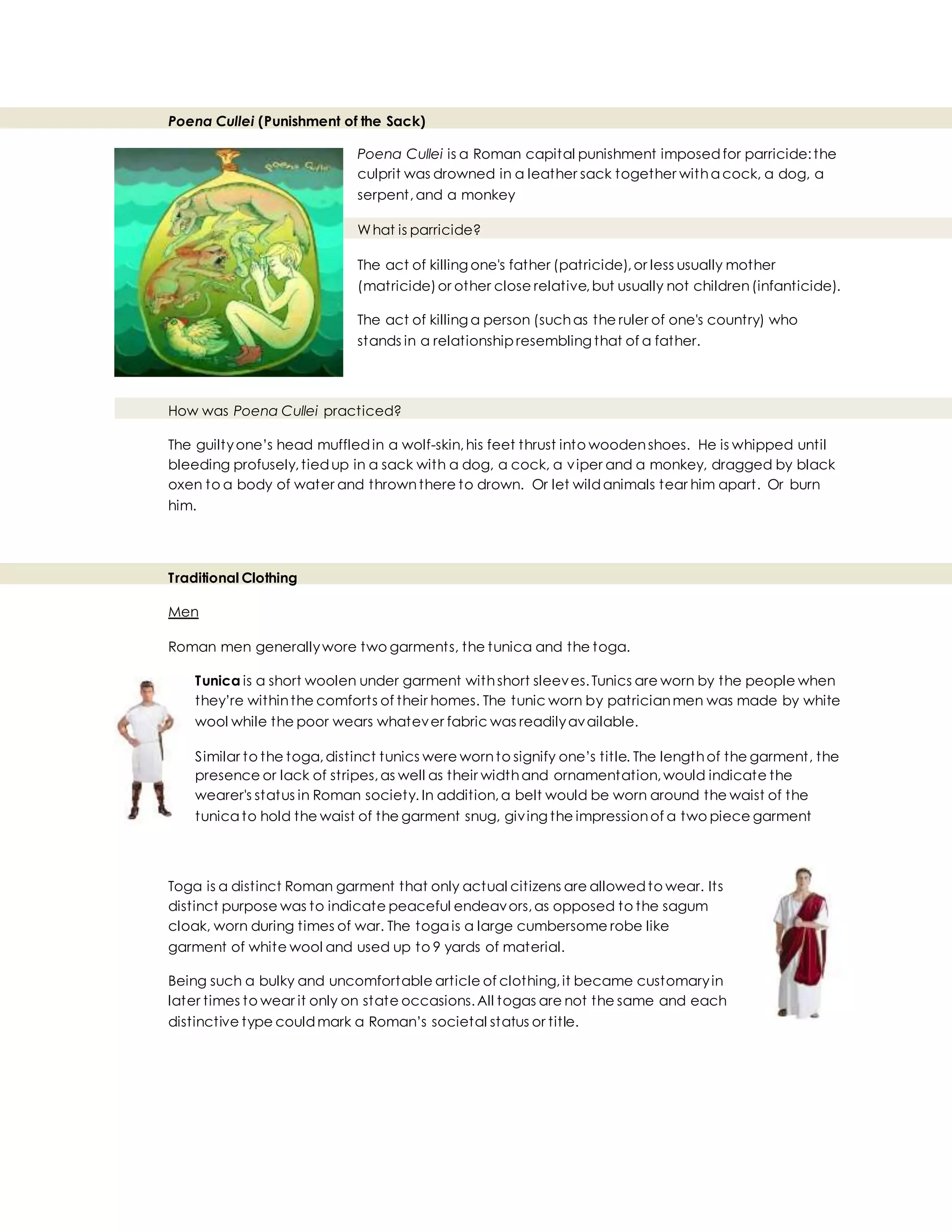
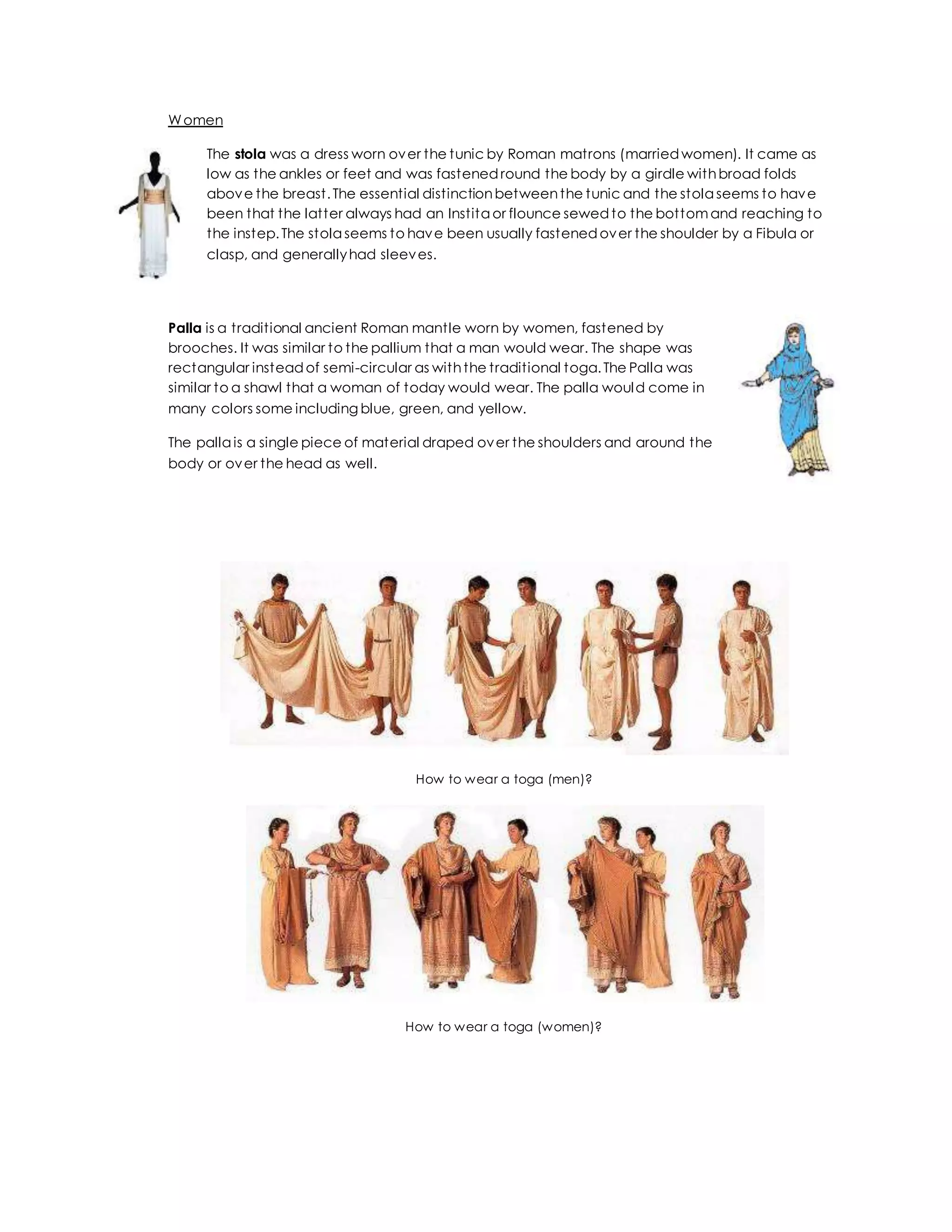
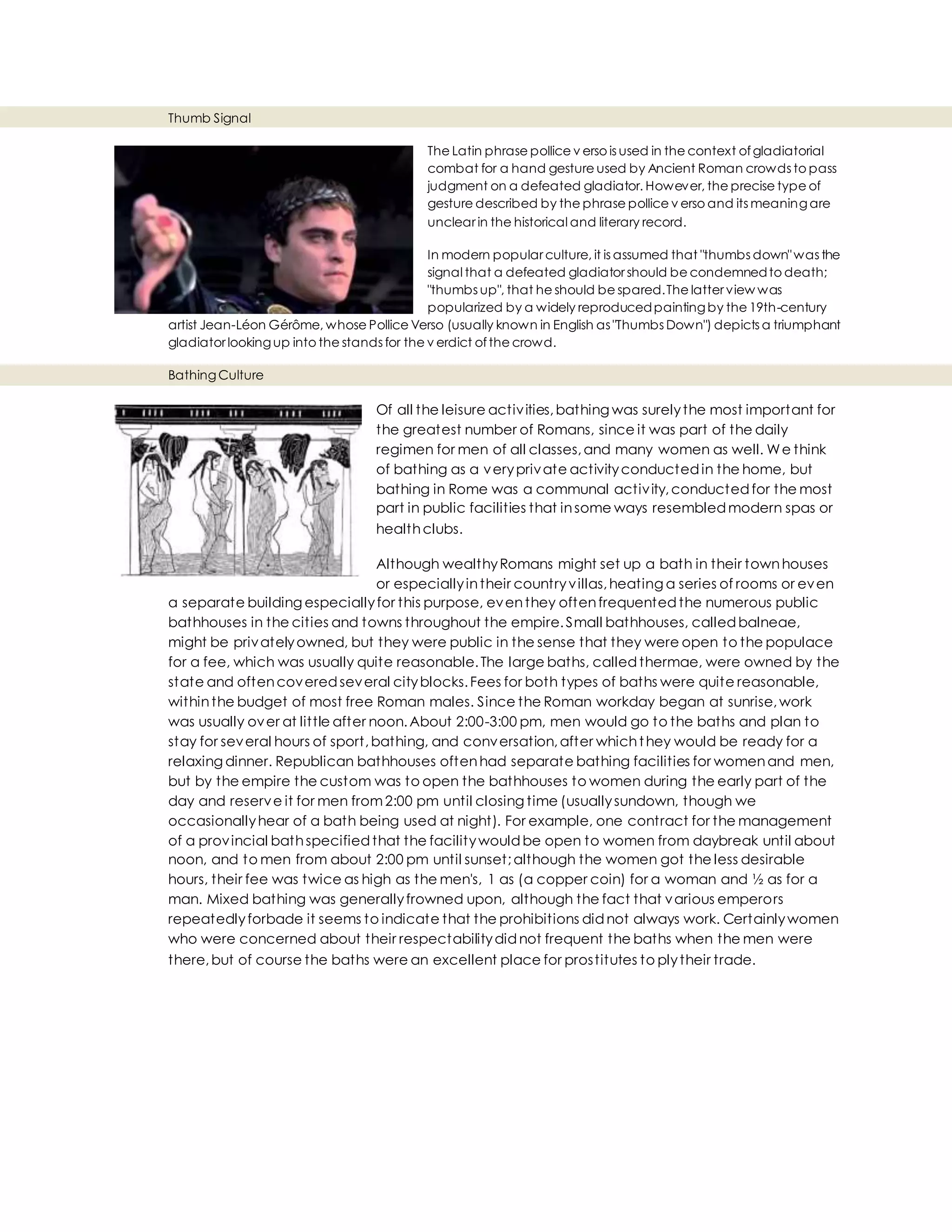

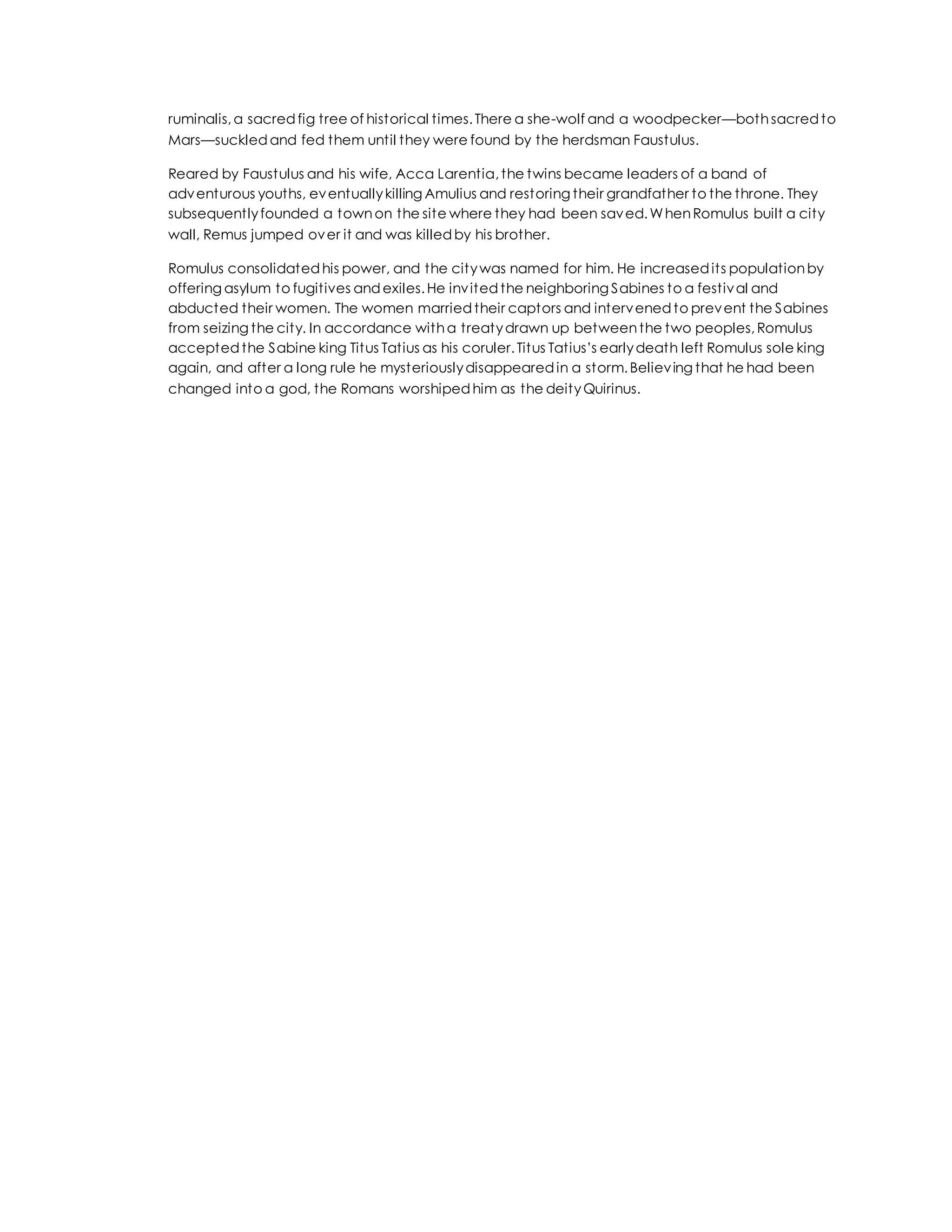
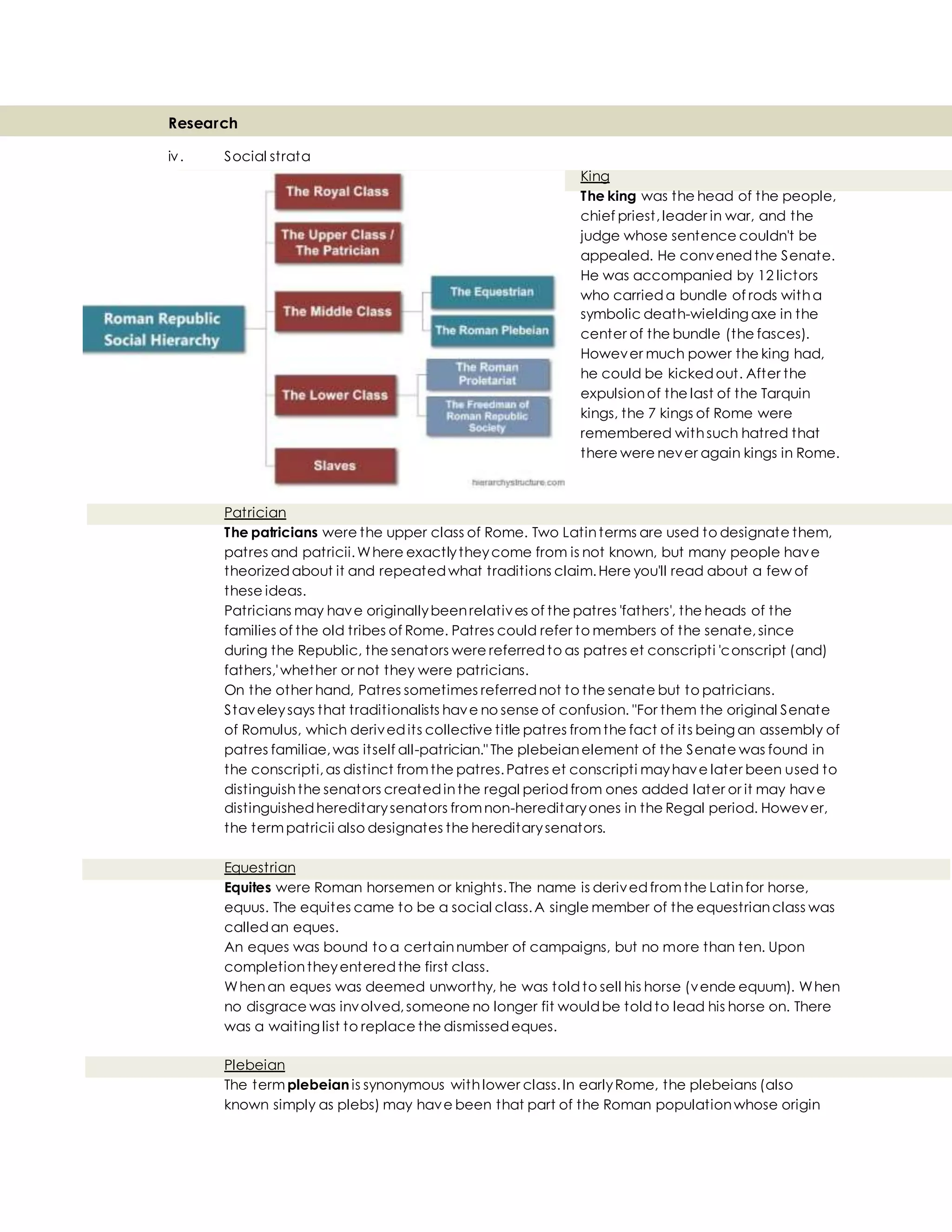
![was among the conquered Latins (as opposed to the Roman conquerors). Plebeians were
contrastedwiththe patriciannobility.Inthe periodof the earlyRoman Republic,
membership in the Senate may have been denied to the plebeians,and restrictedto the
patricians.Since the ruling body of the Senate was more interestedinitself thanothers,the
plebeians suffered. Over time the plebeians were able to amass wealthand great power.
By the time of Caesar, the patricianClaudius chose to become a plebeian (something he
could do through adoption) in order to hold an important political office,the Tribune of
the Plebs.
Proletariat
In contrast withthe plebeians,who startedas the poor, but wound up with power and
money, and the noble patricians,who startedout withland and continuedto hold certain
aristocratic privileges,the landless proletariat was the lowest class of citizens inancient
Rome. It was for the proletariat that the Romans institutedthe dole that we commonly
hear called"bread and circuses." By bread and circuses is meant public entertainment in
the arena (circuses)and a rationof grain (bread). The first part of the word proletariat
contains the Latinword proles,which means offspring.The proletariats were "producers of
offspring."
Freeman
Rome differedfromGreek city-states inallowing freedslaves to become citizens.The act
of freeing a slave was called manumissio, from manus, "hand" (inthe sense of holding or
possessing something),and missio,the act of releasing.After manumission, a slave who
had belonged to a Roman citizenenjoyed not only passive freedomfrom ownership, but
active political freedom (libertas),including the right to vote.[1] A slave who had acquired
libertas was thus a libertus ("freedperson," feminine liberta)inrelationto his former master,
who then became his patron (patronus).
Slaves
They were people who were frequentlycaptured in battle and sent back to Rome to be
sold. However,abandoned childrencould also be brought up as slaves.The law also
statedthat fathers couldsell their older childrenif they were in need of money.
Once bought, a slave was a slave for life.A slave couldonly get their freedomif they were
givenit by their owner or if they bought their freedom. To buy your freedom, you had to
raise the same sum of money that your master had paid for you – a virtually impossible task.
If a slave is marriedand had children, the children would automaticallybecome slaves.
Young childrenwere sometimes killedbytheir parents rather than let them become slaves.
A slave’s day began at daybreak. If his master livedina cold climate,the first job of the
day for a day would be to fire up the hypocaust. Whenhis master awoke, a slave would
be expectedto assist dressing him. Whenthe day properlybegan, a whole group of slaves
startedset tasks,suchas walking children to school,cleaning a villa,washing clothes,
tidying a garden etc. A group of slaves wouldwork in a kitchenpreparing the day’s meals.
Whena richman and his family bathed at home, slaves wouldhelp out by drying them
once they had finishedand dressing them. Whena master movedaround, slaves would
carry him in a litter.Whena master entertained,slaves wouldensure a constant supply of
food and drink. If guests had to returnhome and it was dark, a slave or slaves wouldwalk
ahead of them witha lightedtorch.](https://image.slidesharecdn.com/group-compilation-150201073422-conversion-gate01/75/Group-compilation-15-2048.jpg)

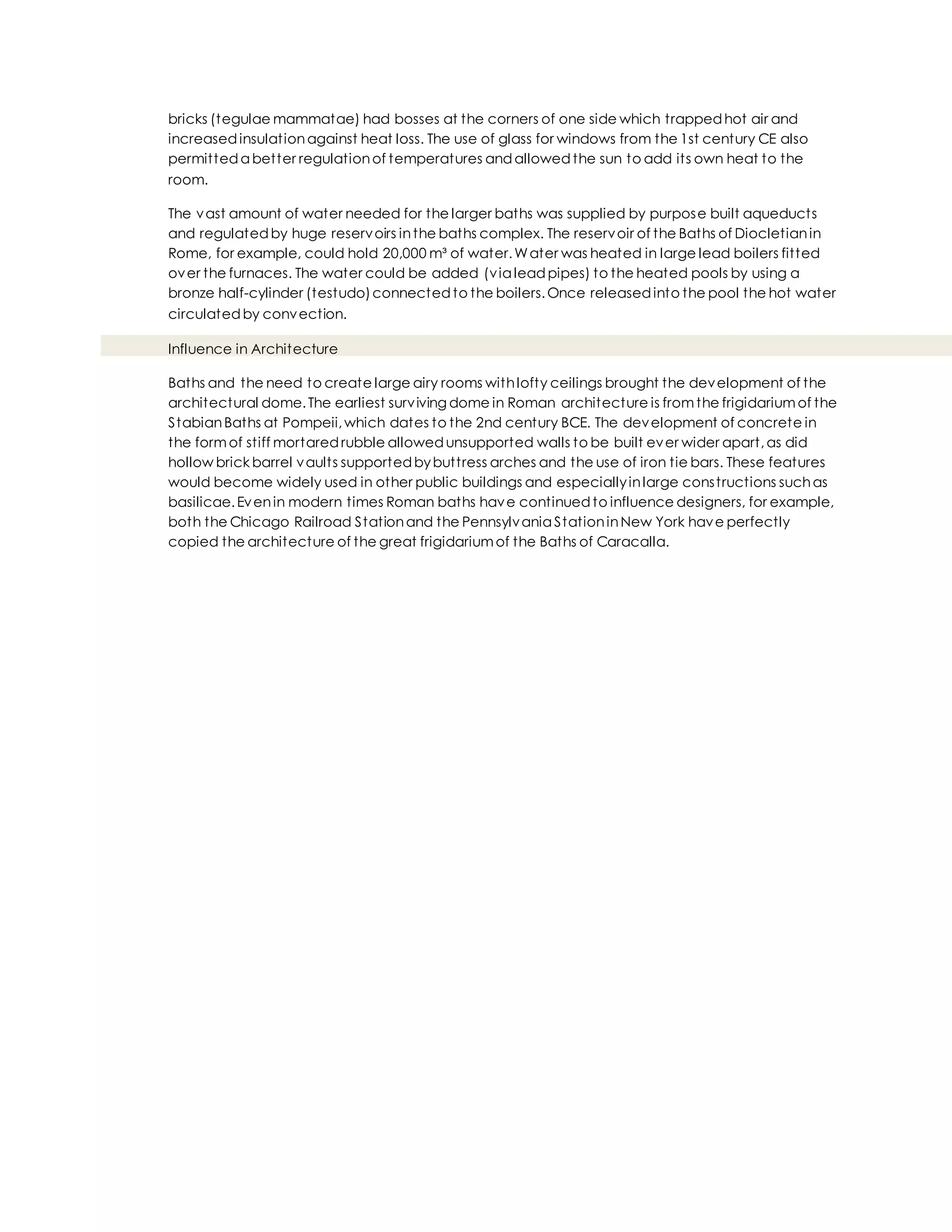
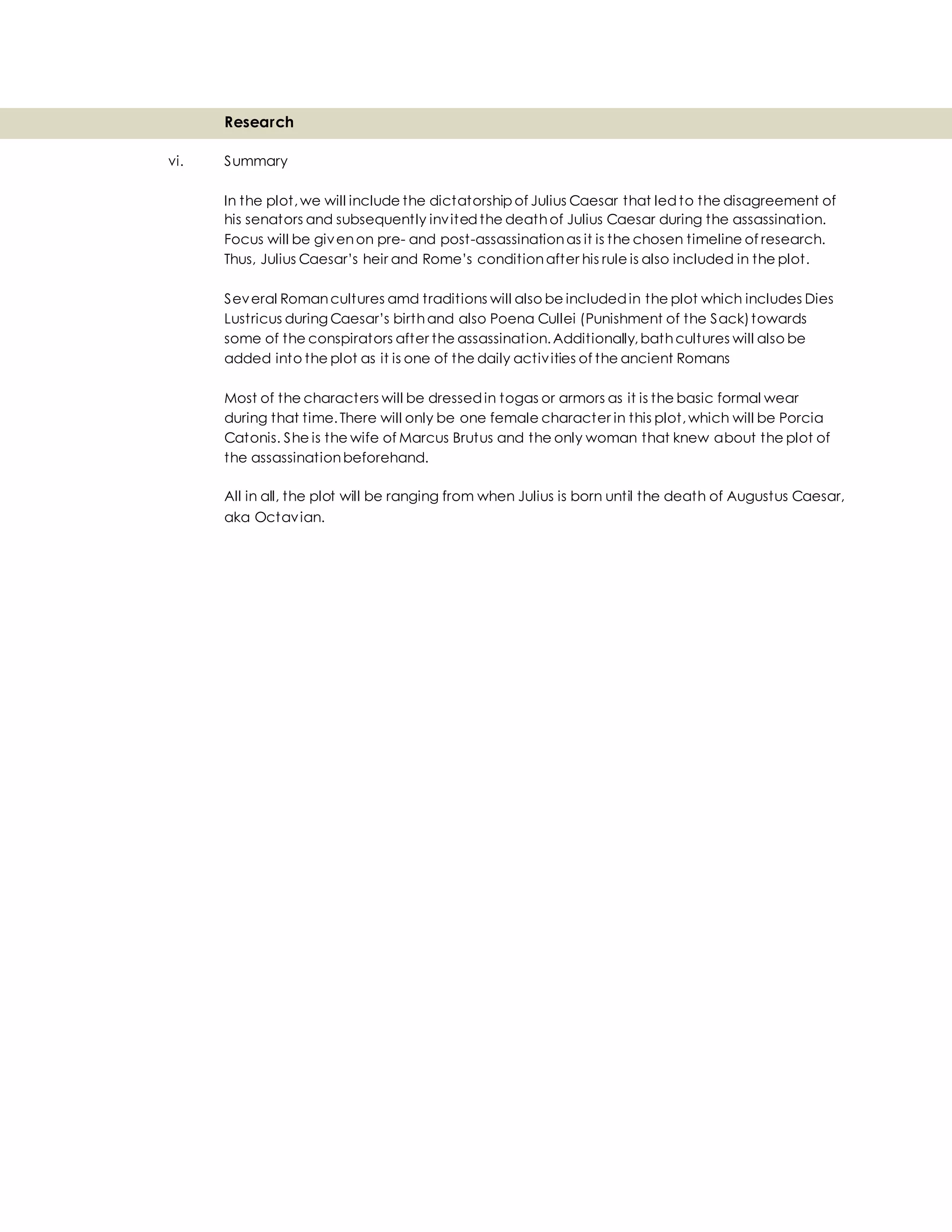
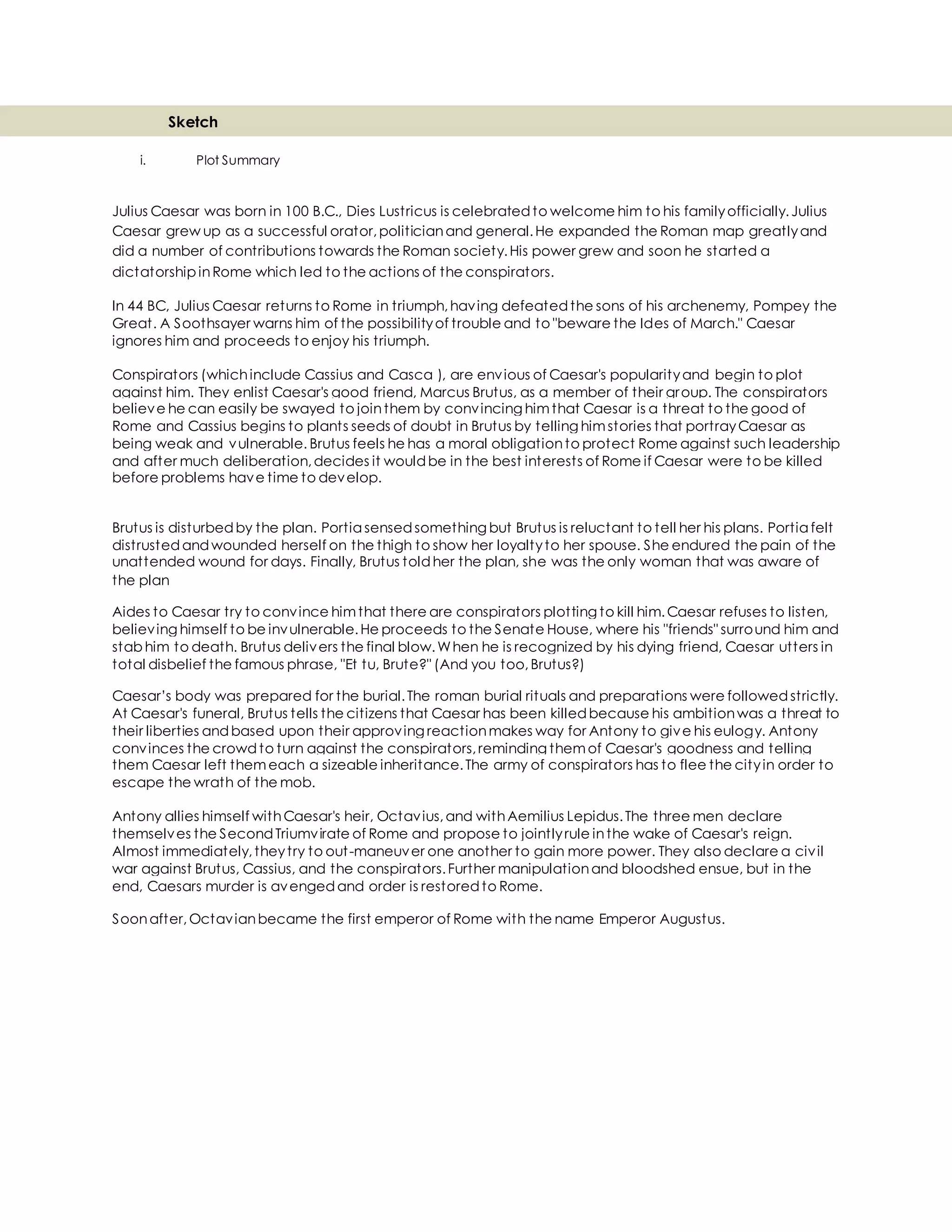
![ii. Script
ACT 1: EARLY LIFE OF JULIUS CAESAR
Scene 1: Day of Purification ofJulius Caesar
Synopsis: The 8th day purification ritual after the birth ofJulius Caesar
On the 9th day after the baby was born, Dies Lustricus is celebrated withjoy in the family of Caesar.
Slav e: What a beautiful baby! Here’s a clay charm for your crepundia. May it ward offthe ev il spirits around
you.
Pope: [Carries baby out from the cot and placed him on his father’s feet]
Father: [Lifts baby from his feet] JULIUS CAESAR SHALL HE BE NAMED!
Pope: On this blessed day shall we welcome a baby boy, Julius to the Caesar’s. May he grow up with health
and peace to become a strongman! [Wears a bulla on the baby]
******END OF SCENE******
Scene 2: Julius Caesar the Dictator
Synopsis: Changes made by Julius Caesar.
At a youngage, Julius Caesar was inv olvedin the Roman military. He then began his career as a lawyer at the age of22
because ofhis fluency in speech. He was eventually elected as consul whichwas a pointoftime when his power started
to grow.
Duringhis years of gov erningRome, he made changes that are still used until present times. For example:
Peasant 1: What day is today?
Peasant 2: 45th day of July
Peasant 1: Are you still using the old calendar? It has beenchanged, don’t you know?
Peasant 2: Oh really? Do you have a copy ofit?
Peasant 1: Ofcourse, Let me search for it.. There! For the new calendar, there are only 12 months in a year and
30 days in a month. It’s actually accordingto the constellation.
Peasant 2: Oh I see… This must be one of the changes done by General Caesar.
Peasant 1: [Nods head]
Meanwhile in Caesar’s residence,
Brutus: Welcome home The Great General! Another land conquered.Have I ever told you that you NEVER LOSE
A WAR?
JC: Thanks for the welcome Brutus. How was the state while I’m away?](https://image.slidesharecdn.com/group-compilation-150201073422-conversion-gate01/75/Group-compilation-20-2048.jpg)
![Brutus: Well ev erythingwent well; we made the changes you requested on the law andenforcement. The
people were happywith it.
JC: They should be happy. Justice will be serv edwiththose changes; the Romans will liv e a better life.
Brutus: All thanks to you!
Julius Caesar’s power increased day by day. His great power then, eventually, led to his death…
******End of Scene******
ACT 2: ASSASINATION OF JULIUS CAESAR
Scene 1: Alliance between Casca, Cassius and Brutus.
Synopsis: Casca and Cassius convinced Brutus( a close friend of JC to join their plan to assassinate JC.
Setting: Bath house
Just as any other Romans, Brutus was cleaninghimselfin the bath house after a longdays work. He was enjoyinghis bath
whilst singinghis fav orite song. *Singingin the shower~*. Suddenly, there were unwantedguests in his priv ate cubicle. He
felt insecure.
Cassius and Casca: Greetings Brutus.
Brutus: Oh what a “pleasant surprise”
Cassius: Pleasant indeed. In fact, we have plottedsomethinginterestingandwouldlike you to lead us.
Brutus: I hav e nothingto do with all your ev il plans. Leavethis place before I call the guards.
Casca: Why the hassle? Don’t you thinkJulius had beentoo dominant?Don’t you feel annoyed when he
bosses around everything?Don’t you feel like gettingrid of him once and for all?
Cassius: He’s gradually imaginghimselfas an aspiringking. It has been 5 centuries since we allowed a kingto
rule us. Clearly a monarchial rule is the last thingus Romans wants, Brutus.
Brutus: Stop all these nonsense! He’s my friend! *Don’t call my name Don’t call my name*
Cassius: Only a fool will take him as a friend.
Casca: Thinkabout it Brutus.
After another few times of brainwashing, Brutus fell into the trap by trustingthe words ofCassius and Casca. He allied
with them and plannedthe assassinationthoroughly. [Guys continue to silent talk. Then shakes hand]
******END OF SCENE******
Scene 2: Portia, the only woman that knew the plot.
Synopsis: Portia hurt herselfon the thigh to prov e her trustworthy.
Setting: Roman home](https://image.slidesharecdn.com/group-compilation-150201073422-conversion-gate01/75/Group-compilation-21-2048.jpg)
![Back at home, Portia was preparingdinner for the family. She was troubled by the thought ofbeingdistrusted by her
husband,Brutus.
[Monologue] Brutus had beenweird these days; he didn’t evenfinish his fiv e bowls ofrice yesterday. He
seemed troubled but he wouldn’t tell. Am I not trustworthy to him? Whyis he hidingfrom me?
To prov e her trustworthiness, Portia madea deep cut on her thigh and left the woundunattended. She hopes to earn
Brutus trust by enduringthe pain on her wound. And finally she succeeded.
Brutus: My beautiful wife, do not feel terrified as I announce to you thatI shall kill Julius Caesar!
Portia: [Startled face]
******END OF SCENE******
Scene 3: The Assassination
Synopsis: JC was killed with 23 stabs all ov er his body.
Setting: Senatorial Hall
Antonio was walkingdown the Hall when he overheardBrutus andCassius’ conversation.
Cassius: JC will be attendingthe senatorial meetingtoday. It’s our only chance but wehave limited time. JC
will be headingeast after the meeting.
Brutus: I will inform the others about the assassination. We will surround him in the hall, he shall not escape!
Cassius: We shall not fail. For Rome!
Antonio: [Monologue] JC is in danger. I have to stop him from enteringthe senate!
The plotters however hadanticipatedthis. Fearingthat Antonio will come to Caesar’s aid, they assigned Casca to stall
him from approachingCaesar by detaininghim outside ofthe Theatre ofPompeii. Meanwhile, the conspirators crowded
around Caesar in the hall.
Brutus: [Giv ingsupport to JC] Watchyour step Caesar.
JC: [Waves him away]
Brutus: [Grabs JC’s shoulder and tore his tunic]
JC: Why. THIS ISVIOLENCE!
Casca: [Tookout his dagger and thrust at JC’s neck]
With a quickturn and a catch, JC savedhimselffrom the attacker.
JC: Casca, you v illain, what are you doing?
Casca: Help brothers!
Within moments, the dictator was stroked with multiple stabs. Blinded by his blood, he tripped, andfell. Defenseless, he
lay on the floor with 22 stabs. Duringthe commotion, he saw a familiar face, Brutus.](https://image.slidesharecdn.com/group-compilation-150201073422-conversion-gate01/75/Group-compilation-22-2048.jpg)
![JC: Et tu, Brute?
Brutus: [Comes forward. Kneel down andsupportedJC from the back. Stabs JC on the chest.]
JC: [Dies]
Brutus: ROME IS FREE AGAIN!!
******End of Scene******
Scene 4: Funeral and Burial of Julius Caesar
Caesar’s body was preparedfor burial. His body was washedandscrubbedbefore puttinghim into his finest clothes. All
the crowns and tokens he earned is put together with the corpse. A golden coin was placed in his mouth to pay for the
boat ride to the underworld.
At his funeral,
Brutus: Julius Caesar, our mighty general was killed because his ambition is becominga threat to us. He
deserv es deathas he was planningto force Rome into a monarchial system!
Antonio: NONSENSE! Julius never had any planofgettinghimself a throne. It was a case of murder out of
jealousy! As a friend I am totally disappointed in your actions andmaturity. Have you forgotten all the good of
Caesar? He risked his life in battles for a better life for the Romans. He didn’t risk his life for himself. In fact he left
us each a sizeable inheritance. [Facingthe crowd] These people are murderers! They cannotlive!
Augustus: Here I stand as the heir of Caesar, these conspirators must die. People of Rome… [Raises thumb to
the air]
With the agreement ofthe mob, the conspirators were giv en deathsentences. Brutus, Cassius and Cascawere left in a
sack with a snake, a chicken, a monkey and a dog. They were then thrown into the sea. Since then,they were never
heard.
******End of Scene******
ACT 3: AUGUSTUS CAESAR ANDTHEDEMOCRATICROME
Scene 1: Augustus inherited Rome as Emperor
After the burial of the late Julius Caesar, and the deathofthe conspirators, Antonio allied with Lepidus andOctavian,
forming the second triumv irate to jointly rule Caesar’s reign.
Antonio: We will share our power by dividingthe territories. Any objections?
Augustus: I agree with a condition, the west will be under my control
Antonio: Certainly, and I will take the east and Lepidus shall take Africa.
Augustus: For peace and Rome. Prost!
Soon after, Augustus Caesar was crowned as the first emperor in the Roman history. The coronation was held.](https://image.slidesharecdn.com/group-compilation-150201073422-conversion-gate01/75/Group-compilation-23-2048.jpg)
![Pope: Hear our prayer, Lord, and those ofyour serv ant. Look, Almighty God, with a serene gaze on this, your
glorious serv ant,... [Place golden crown] Through whom honor andglory are yours through infinite ages of ages.
Amen. [Passes sword]
Pope: Receiv e this sword bythe hands ofbishops, who, thoughunworthy, are consecratedto be in the place
and authority of the holy Apostles, deliver it to you, with our blessing, to serv e for the defense of the holy Church,
div inely ordained, andremember ofwhom the Psalmist prophesised, saying, 'Gird the sword upon your thigh, O
most Powerful One, that with it you may exercise equity.
Augustus: I, Augustus Caesar take my oath as the emperor of Rome. I shall protect my land, expand it. Rome
shall be the richest land with educatedpeople. I will protect the dignity ofmy land with my life. Rome and I
shall be as one!
Pope: And I announce you Emperor Augustus. You may kiss your throne.
******End of Scene******
Scene 2: Augustus Caesar expands the mapofRome.
The crowningofAugustus Caesar started a monarchial system in Rome. As promised, he improv ed life at Rome.
Augustus: Anthony, get the finest craftsmen to fix the temples around.
Anthony: Yes your majesty.
Augustus: And also the public facilities, we’ll have marbles on the wall. And also send orders to repaint all
gov ernmental andholy buildings white.
Anthony: Your words shall be made reality sire.
Within the year, 82 temples in Rome were fixed and religion was giv en attention once again. Besides, Augustus Caesar
also kept his promise on the map ofRome.
Augustus: [Looking at map] There is still so many land not conqueredon this map. I shall take them down one
after another. Hmm, let’s see.. Britain shall take the lead. PREPARE THE TROOPS! WE SHALL LEAVE IN A MONTH.
Year after year, Augustus Caesar expanded the Roman map, from Britain to Spain and Turkey. [Romanmap expands]
Under Augustus Caesar’s care, Rome entered Pax Romana, which was 200 years ofpeace.
Augustus Caesar died at the age of 77, his empire secured and peace. Soon after his death, ARoman Senate officially
declared their departedemperor, like Julius Caesar before him, to be a god.
Before his last breath, Augustus said to his follower
Augustus: I found Rome of clay; I leav e it to you of marble.
******END OF PLAY******](https://image.slidesharecdn.com/group-compilation-150201073422-conversion-gate01/75/Group-compilation-24-2048.jpg)


